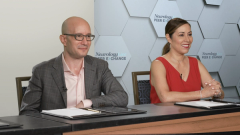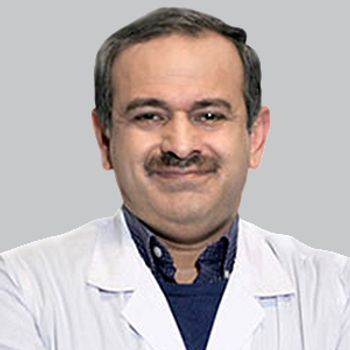
Safety Considerations and Monitoring for S1P Modulators in MS
Heidi Crayton, MD, and Jacqueline Nicholas, MD, review the importance of long-term safety data in the management of patients with multiple sclerosis, and Flavia Nelson, MD, discusses her approach to counseling patients on the safety considerations regarding new S1P modulating agents.
Episodes in this series

Stephen Krieger, MD: Another nice point, now that we’re a dozen years into the S1P era, is that we’ve seen long-term data sets for many agents in this class. Even with the newer ones, like ponesimod, longer-term follow-ups from their trials are reaching the conferences and journals. Dr Crayton, do you have an overall takeaway on the long-term safety data or any specifics that have jumped out at you?
Heidi Crayton, MD: The significance is that there’s no long-term safety signal that pops up. We have consistent safety data, which is the key takeaway. It’s important for patients also. I know when fingolimod came out, it was the first time something was new to the market for a while. People consistently said, “I don’t necessarily want to be a guinea pig. I don’t want to be the first.” I’d remind them that the injectable products that they’d been taking came to market based on clinical trials with hundreds of people and shorter duration. Now, when products come to market, it’s based on experience with thousands of patients, and there’s long-term extension data that we have so you’re far from being the first or the guinea pig. Times have changed. By the time something is getting to our patient, there’s so much data that are known. That should bring us all comfort as prescribers and as patients who are consumers of these products. I do try to impart that information to patients: that we have 5-year or 5-year plus long-term safety data, which is pretty boring, quite frankly. Boring is good.
Stephen Krieger, MD: That’s what we look for. How about monitoring the safety? Dr Nicholas, are there specific things that you do to monitor the safety of S1P as a class? Are there particular things you tell patients that you’re going to look out for and that they should look out for?
Jacqueline Nicholas, MD: There are a few things. At baseline, we want to see where the complete blood count is and make sure that we know where those absolute lymphocyte counts live from the beginning because we know based on the mechanism that we’re going to see a reduction there. That’s something that periodically, after initiation, we monitor again just to make sure we’re not going too low, which I think is below 200 per mm3 on the absolute lymphocyte count. Another thing we monitor for is very basic: making sure we’re looking at their blood pressure, so we know as a class. Certainly, we can see hypertension with these agents. As we’ve mentioned, sometimes these folks think of us as their primary care, so we want to make sure we’re checking on that from time to time.
We also know there’s a rare risk of macular edema with these agents. We make sure to talk to them a little about that in terms of baseline, taking a look and making sure they don’t have macular edema to begin with or diabetes, in which case they may be at higher risk and we want to be careful. That’s something we can reevaluate over time.
Then there are more rare things. As neurologists, we need to be aware that there’s a rare risk of PML [progressive multifocal leukoencephalopathy]. As we tell all our patients, if you have any new neurological symptoms, we’d like to hear from you. Don’t delay, because that’s something we’re going to screen for. With headaches, although they’re a common adverse effect with S1Ps, there have been rare cases of cryptococcal meningitis. We need to be mindful of that. They’re more rare in the hospital world. Of course, we can see things like PRES [posterior reversible encephalopathy syndrome]. There are a few things we want to keep an eye on, but the monitoring requirements outside routine care of MS [multiple sclerosis], which we’re monitoring with MRIs, are pretty minimal and rather easy.
Stephen Krieger, MD: You’re right. The 2 rare infections you mentioned, PML and cryptococcal meningitis, are vanishingly uncommon with the S1Ps. Nonetheless, we think about them. I’ll add a common infection, which is how we think about COVID-19 with patients on the S1P modulators. My take on the data so far is that this class of agents has not significantly increased risks from COVID-19—morbidity, hospitalization, or mortality from it. That’s comforting. We’ve seen a lot of data from different studies, including 1 done by 1 of my colleagues, Dr Sophia Ryan at Mount Sinai Hospital, that the S1P modulators as a class decreased the antibody response seen after vaccination. We recognize that, but thankfully this class doesn’t seem to be associated with worse COVID-19 outcomes. Now that there are antivirals and other treatments for COVID-19, I hope that will be less of a pressured concern for patients on this and other classes of medicine.
Stephen Krieger, MD: Dr Nelson, is there anything else you’d like to add about some of the nuances in safety monitoring, let’s say among some of the newer agents in the S1P class?
Flavia Nelson, MD: Yes, it applies to all of them. But I counsel my patients on whether they’re planning on getting pregnant and if they’re on 1 of these medications that it needs to be stopped when they consider conception. The other thing is that I put a lot of emphasis on not stopping these drugs cold turkey. They need to be tapered. Also, we need to make sure we put you on something else because it could be risky to stop them abruptly and not go on another disease-modifying therapy. I tell them if—for whatever reason—you decide you don’t want to take it anymore, let me know and we’ll have a plan of action because it’s been shown that in approximately 2 to 3 months after stopping S1P or S1P1, you can have a significant amount of inflammation in the brain in the form of enhancing lesions. Depending where the lesion is, it could cause a relapse. That can be significant and potentially cause irreversible disability.
Stephen Krieger, MD: That’s an excellent point. The concept of rebound when stopping S1P modulators came from fingolimod. I don’t know that it’s obvious that that happens to the same degree with the more recently approved S1P. It probably does in principle, so I agree. I always tell my patients that there needs to be a next-step plan if one is going to stop a medicine in this class, so that there’s a transition of treatment to avoid rebound.
Flavia Nelson, MD: Perhaps, we don’t have enough data for the new ones, but it seems to me that it could happen. We need to be cautious always.
Transcript Edited for Clarity
Newsletter
Keep your finger on the pulse of neurology—subscribe to NeurologyLive for expert interviews, new data, and breakthrough treatment updates.























